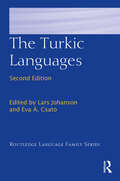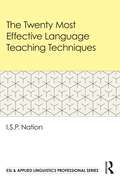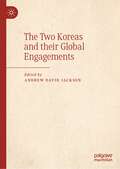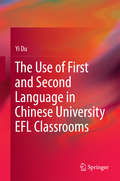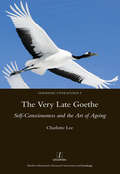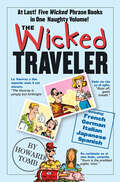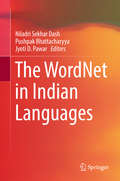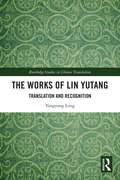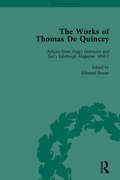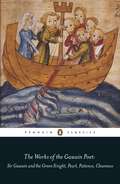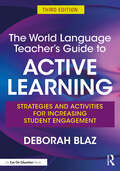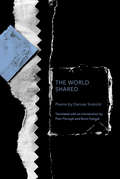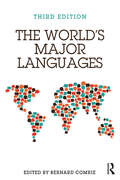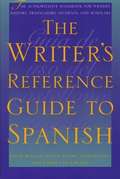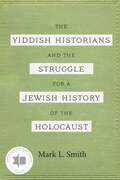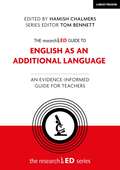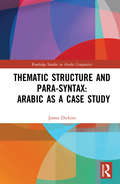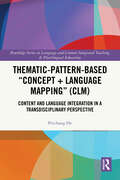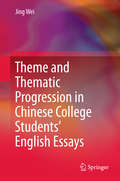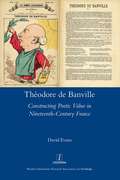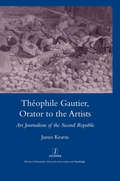- Table View
- List View
The Turkic Languages (Routledge Language Family Series)
by Lars Johanson Éva Á. CsatóThe Turkic languages are spoken today in a vast geographical area stretching from southern Iran to the Arctic Ocean and from the Balkans to the great wall of China. There are currently 20 literary languages in the group, the most important among them being Turkish with over 70 million speakers; other major languages covered include Azeri, Bashkir, Chuvash, Gagauz, Karakalpak, Kazakh, Kirghiz, Noghay, Tatar, Turkmen, Uyghur, Uzbek, Yakut, Yellow Uyghur and languages of Iran and South Siberia. The Turkic Languages is a reference book which brings together detailed discussions of the historical development and specialized linguistic structures and features of the languages in the Turkic family. Seen from a linguistic typology point of view, Turkic languages are particularly interesting because of their astonishing morphosyntactic regularity, their vast geographical distribution, and their great stability over time. This volume builds upon a work which has already become a defining classic of Turkic language study. The present, thoroughly revised edition updates and augments those authoritative accounts and reflects recent and ongoing developments in the languages themselves, as well as our further enhanced understanding of the relations and patterns of influence between them. The result is the fruit of decades-long experience in the teaching of the Turkic languages, their philology and literature, and also of a wealth of new insights into the linguistic phenomena and cultural interactions defining their development and use, both historically and in the present day. Each chapter combines modern linguistic analysis with traditional historical linguistics; a uniform structure allows for easy typological comparison between the individual languages. Written by an international team of experts, The Turkic Languages will be invaluable to students and researchers within linguistics, Turcology, and Near Eastern and Oriental Studies.
The Twenty Most Effective Language Teaching Techniques (ISSN)
by I.S.P. NationFrom leading scholar and applied linguist Paul Nation, this book describes and explains the 20 most effective and efficient language teaching techniques and why they work. Backed by decades of research and expertise, Nation examines the principles of learning connected to these techniques, as well as the factors affecting their choice and usage.These techniques are organized around the four skills of listening, speaking, reading, and writing. For each skill, there is an opportunity for learning through meaning-focused use, an opportunity for learning through deliberate study, and a window for fluency development through working with easy material. Each technique is described and analyzed to demonstrate its learning goals and the principles of learning in use.In demonstrating key techniques and methods for language learning, this book is particularly useful for pre-service teachers and students in applied linguistics, TESOL, and language teaching. Each chapter also has a substantial list of research topics for projects or theses.
The Two Koreas and their Global Engagements
by Andrew David JacksonThis book departs from existing studies by focusing on the impact of international influences on the society, culture, and language of both North and South Korea. Since President Kim Young Sam’s segyehwa drive of the mid-1990s, South Korea has become a model for successful globalization. In contrast, North Korea is commonly considered one of the least internationally integrated countries. This characterization fails to account for the reality of the two Koreas and their global engagements. The opening essay situates the chapters by highlighting some significant contrasts and commonalities between the experiences of North and South Korea’s history of engagement with the world beyond the Peninsula. The chapters explore both the longer-term historical influence of Korea’s international contacts as well as specific Korean cultural, linguistic, and social developments that have occurred since the 1990s demise of the global Cold War and greater international integration.
The Upanishads Volume 2
by Joseph Campbell Swami NikhilanandaSwami Nikhilananda's English translation of three of the major Upanishads - Svetasvatara, Prasna, and Mandukya - offers a scholarly, yet readable version of the sacred texts of ancient India. The Upanishads form the foundation of the Hindu religion and describe the ultimate objective of life - the liberation of the soul from the bondage of the phenomenal world. Swami Nikhilananda's clear and insightful writing combined with notes and explanation based on the commentary of Sankaracharya, the great eighth-century philosopher and mystic of India, will help the spiritual seeker delve into the meaning of these spiritual treasures. This second of four volumes also contains an introduction with a general outline of Hindu ethics.
The Use of First and Second Language in Chinese University EFL Classrooms
by Yi DuThis book investigates first language (L1) and second language (L2) use in Chinese university classrooms, focusing on the experiences of four Chinese EFL teachers who were teaching non-English major students at four different proficiency levels. It examines these four teachers' actual use of L1 and L2, including the distribution of their L1 and L2 use; the circumstances, functions and grammatical patterns of their language use; and their language use across different frames of classroom discourse. It also explores their attitudes and beliefs regarding this issue in depth, as well as their own perceptions of and reasons for their language use and possible influencing factors. Through its detailed analysis of the teachers' language use, as well as their respective beliefs and decision-making techniques, this book contributes to L2 teachers' professional development and L2 teaching in general, especially with regard to establishing a pedagogically principled approach to L1 and L2 use.
The Valentine Generation and Other Stories (Structural Readers)
by John UpdikeAn anthology of short stories from John Updike, John Wain, Doris Lessing, Frank Tuohy, H. E. Bates, and Elizabeth Taylor. After the stories are exercises in comprehension and structure.
The Very Late Goethe: Self-Consciousness and the Art of Ageing
by Charlotte LeeGoethe's career was an unusually long and productive one: he became a literary celebrity in the 1770s and remained so until his death in 1832. The distinguishing feature of his last works is their self-consciousness, their preoccupation both with the business of writing and with personal development. In the first cross-genre study of this period of Goethe's work, Charlotte Lee traces the theme in his last major poems and autobiographical writings, before turning to the two 'giants', 'Wilhelm Meisters Wanderjahre' and 'Faust II'. All these works share a tendency to allude subtly to earlier moments from Goethe's own literary output, but to fashion them into writing which is quite new - even though (or perhaps because) he himself is old. This book seeks to understand the unique perspective of one nearing the end of a long life.
The Wicked Traveler: 8-copy Counter Display (Wicked Travel Ser.)
by Howard Tomb<P>Respond to Japanese Noh theater like a native: Kazoku sorrote no seppuku ga yokatta. (“I love the part where the whole family disembowels themselves.”) <P>Speak to homicidal Parisian taxi drivers in a language they’ll understand: Ou avez-vous appris à conduire? <P>En Italie? (“Where did you learn to drive? Italy?”) <P>Discuss Italian olive oil with the proper degree of reverence: Un assaggio ti dice che le olive sono maturate di fronte ad una cattedrale. (“One taste tells you the olives grew in full view of the cathedral.”) <P>Establish privacy needs in Mexico: Preferiría una habitación sin alacranes. (“I’d prefer a room without scorpions.”) <P>With seven titles and over 1.2 million copies in print, Howard Tomb’s Wicked phrase book series is the fiendishly irreverent—and very successful—collection that gives travelers the words they wish they could utter while, say, attempting to find the exit of the Louvre or facing a plate of fugu (poisonous blowfish) in Japan. Now, the five most popular Wicked books—Italian, French, Japanese, German, and Spanish— have been updated and compiled into The Wicked Traveler. <P>Because, as Howard Tomb writes in his new introduction: “Every country is different, but all foreign places have one thing in common: they’re weird.”
The WordNet in Indian Languages
by Niladri Sekhar Dash Pushpak Bhattacharyya Jyoti D. PawarThis contributed volume discusses in detail the process of construction of a WordNet of 18 Indian languages, called "Indradhanush" (rainbow) in Hindi. It delves into the major challenges involved in developing a WordNet in a multilingual country like India, where the information spread across the languages needs utmost care in processing, synchronization and representation. The project has emerged from the need of millions of people to have access to relevant content in their native languages, and it provides a common interface for information sharing and reuse across the Indian languages. The chapters discuss important methods and strategies of language computation, language data processing, lexical selection and management, and language-specific synset collection and representation, which are of utmost value for the development of a WordNet in any language. The volume overall gives a clear picture of how WordNet is developed in Indian languages and how this can be utilized in similar projects for other languages. It includes illustrations, tables, flowcharts, and diagrams for easy comprehension. This volume is of interest to researchers working in the areas of language processing, machine translation, word sense disambiguation, culture studies, language corpus generation, language teaching, dictionary compilation, lexicographic queries, cross-lingual knowledge sharing, e-governance, and many other areas of linguistics and language technology.
The Works of Lin Yutang: Translation and Recognition (Routledge Studies in Chinese Translation)
by Yangyang LongThe Works of Lin Yutang is the first book to provide a comprehensive study of Lin Yutang’s translation theory and translated (and written) works in English as a whole, examined from the perspective of his pursuit of recognition of cultural equity between China and the English-speaking world. The arc of the book is Lin’s new method of translating China to the Anglophone world, which is crucial to rendering Chinese culture as an equal member of the modern world. This book identifies Lin’s legacy of translation and recognition as his acknowledgement of source and target cultural territories in translation, and at the same time, his questioning of perspectives that privilege the authority of either. This book will appeal to scholars and students in Translation Studies, World and Comparative Literature, Literary and Cultural Studies, and Chinese Studies. It can also be used as a reference work for practitioners in translation and creative writing.
The Works of Thomas De Quincey, Part III vol 17
by Barry Symonds Grevel LindopThomas De Quincey (1785-1859) is considered one of the most important English prose writers of the early-19th century. This is the final part of a 21-volume set presenting De Quincey's work, also including previously unpublished material.
The Works of the Gawain Poet: Sir Gawain and the Green Knight, Pearl, Cleanness, Patience
by Ad Putter Myra StokesA new volume of the works of the Gawain poet, destined to become the definitive edition for students and scholars.This volume brings together four works of the unknown fourteenth-century poet famous for the Arthurian romance Sir Gawain and the Green Knight, in their original Middle English. In one of the great tales of medieval literature, Gawain, the noblest knight of King Arthur's court, must keep a deadly bargain with a monstrous knight and resist the advances of his host's beautiful wife. The dream vision of Pearl depicts a bereaved father whose lost child leads him to glimpse heaven. And in moral poems based on stories from the Bible, Cleanness warns against sins of the flesh and of desecration, while Patience encourages readers to endure suffering as God's will.Little is known about the so-called 'Gawain poet', who wrote during the late fourteenth century. It is believed that he came from south-east Cheshire, an important cultural and economic centre at the time, and he was clearly well-read in Latin, French and English. Although he is not named as the author of Sir Gawain and the Green Knight, Pearl, Patience, Cleanness, the four works have been attributed to him based on a careful comparison of their language, date and themes.Myra Stokes was formerly Senior Lecturer in the Department of English at Bristol University. Her books include Justice and Mercy in Piers Plowman and The Language of Jane Austen.Ad Putter teaches at the English Department and the Centre for Medieval Studies of the University of Bristol, where is Professor of Medieval English Literature. His monographs include Sir Gawain and the Green Knight and French Arthurian Romance and An Introduction to the Gawain Poet, and he is also co-editor of The Cambridge Companion to the Arthurian Legend.
The World Language Teacher's Guide to Active Learning: Strategies and Activities for Increasing Student Engagement
by Deborah BlazEnhance your students’ success and improve the likelihood of retention with the easy-to-implement activities and strategies in this book! Bestselling author Deborah Blaz shows how to create a classroom in which students can actively experience and explore a world language. The new edition features updates in every chapter and incorporates the latest ACTFL standards, more information on teaching with authentic resources, a new chapter on teaching with technology, and additional resources for personalized learning. It is organized to allow you to easily find and pull activities you want to use in your classroom the very next day. You’ll learn how to… mix up your repertoire of activities, games, and exercises to keep students engaged; introduce students to the culture of the language you teach by hosting parties and celebrations; overcome some of the biggest obstacles in the path to fluency, including verb conjugation, using object pronouns, and the subjunctive mood; customize your teaching strategies to accommodate a broader range of talents, skills, and intelligences; implement new assessment strategies to improve verbal skills and reading comprehension; and more! Bonus: Downloadable versions of some of the resources in this book are available on the Routledge website at www.routledge.com/9781032258294 so you can print and distribute them for immediate classroom use.
The World Shared (Lannan Translations Selection Series)
by Dariusz SosnickiDariusz Sosnicki's poems open our eyes to the sublime just beneath the surface of the mundane: a train carrying children away from their parents for summer vacation turns into a ravenous monster; a meal at a Chinese restaurant inspires a surreal journey through the zodiac; a malfunctioning printer is a reminder of the ghosts that haunt us no matter where we find ourselves.Among the perpetrators and victims,buzzed or wasted to the bone,gliding without their blinkers onin the ruts of the national fate—they're not at home.Dariusz Sosnicki is an award-winning poet, essayist, and editor in Poland.
The World's Major Languages
by Bernard ComrieThe World's Major Languages features over 50 of the world's languages and language families. This revised edition includes updated bibliographies for each chapter and up-to-date census figures. The featured languages have been chosen based on the number of speakers, their role as official languages and their cultural and historical importance. Each language is looked at in depth, and the chapters provide information on both grammatical features and on salient features of the language's history and cultural role. The World’s Major Languages is an accessible and essential reference work for linguists.
The Writer's Reference Guide to Spanish
by David William Foster Daniel Altamiranda Carmen De UriosteWriters and editors of Spanish have long needed an authoritative guide to written language usage, similar to The MLA Style Manual and The Chicago Manual of Style. And here it is! This reference guide provides comprehensive information on how the Spanish language is copyedited for publication. The book covers these major areas:- Language basics: capitalization, word division, spelling, and punctuation. - Language conventions: abbreviations, professional and personal titles, names of organizations, and nationalities. - Bibliographic format, particularly how Spanish differs from English. - Spanish language forms of classical authors' names. - Literary and grammatical terminology. - Linguistic terminology. - Biblical names and allusions. - A dictionary of grammatical doubts, including usage, grammatical constructions of particular words and phrases, verbal irregularities, and gender variations.
The Yiddish Historians and the Struggle for a Jewish History of the Holocaust
by Mark L. SmithThe Yiddish Historians and the Struggle for a Jewish History of the Holocaust identifies the Yiddish historians who created a distinctively Jewish approach to writing Holocaust history in the early years following World War II. Author Mark L. Smith explains that these scholars survived the Nazi invasion of Eastern Europe, yet they have not previously been recognized as a specific group who were united by a common research agenda and a commitment to sharing their work with the worldwide community of Yiddish-speaking survivors. These Yiddish historians studied the history of the Holocaust from the perspective of its Jewish victims, focusing on the internal aspects of daily life in the ghettos and camps under Nazi occupation and stressing the importance of relying on Jewish sources and the urgency of collecting survivor testimonies, eyewitness accounts, and memoirs. With an aim to dispel the accusations of cowardice and passivity that arose against the Jewish victims of Nazism, these historians created both a vigorous defense and also a daring offense. They understood that most of those who survived did so because they had engaged in a daily struggle against conditions imposed by the Nazis to hasten their deaths. The redemption of Jewish honor through this recognition is the most innovative contribution by the Yiddish historians. It is the area in which they most influenced the research agendas of nearly all subsequent scholars while also disturbing certain accepted truths, including the beliefs that the earliest Holocaust research focused on the Nazi perpetrators, that research on the victims commenced only in the early 1960s and that Holocaust study developed as an academic discipline separate from Jewish history. Now, with writings in Yiddish journals and books in Europe, Israel, and North and South America having been recovered, listed, and given careful discussion, former ideas must yield before the Yiddish historians’ published works. The Yiddish Historians and the Struggle for a Jewish History of the Holocaust is an eye-opening monograph that will appeal to Holocaust and Jewish studies scholars, students, and general readers.
The researchED Guide to English as an Additional Language: An evidence-informed guide for teachers (researchED)
by Tom Bennett Hamish ChalmersIn this edition, Hamish Chalmers provides a primer on the key questions teachers and researchers have about the education of children learning English as an Additional Language (EAL). From the general implications of teaching children in a language that many are still in the process of learning, to the specifics of EAL-friendly pedagogy, this volume includes contributions from both teachers and researchers in the field: Victoria Murphy, Constant Leung, Jonathan Bifield, Feyisa Demie, Ann-Margaret Smith, Naomi Flynn, Holly Joseph, Tracey Costley, Xiao Lan Curdt-Christiansen, and Eowyn Crisfield.Hamish Chalmers is a lecturer and EAL researcher at the University of Oxford, vice-chair of NALDIC — the UK’s EAL subject association — and erstwhile primary school teacher, both in the UK and overseas.
The researchED Guide to English as an Additional Language: An evidence-informed guide for teachers (researchED)
by Tom Bennett Hamish ChalmersIn this edition, Hamish Chalmers provides a primer on the key questions teachers and researchers have about the education of children learning English as an Additional Language (EAL). From the general implications of teaching children in a language that many are still in the process of learning, to the specifics of EAL-friendly pedagogy, this volume includes contributions from both teachers and researchers in the field: Victoria Murphy, Constant Leung, Jonathan Bifield, Feyisa Demie, Ann-Margaret Smith, Naomi Flynn, Holly Joseph, Tracey Costley, Xiao Lan Curdt-Christiansen, and Eowyn Crisfield.Hamish Chalmers is a lecturer and EAL researcher at the University of Oxford, vice-chair of NALDIC — the UK’s EAL subject association — and erstwhile primary school teacher, both in the UK and overseas.
Thematic Structure and Para-Syntax: Arabic As A Case Study (Routledge Studies in Arabic Linguistics)
by James DickinsThematic Structure and Para-Syntax: Arabic as a Case Study presents a structural analysis of Arabic, providing an alternative to the traditional notions of theme and rheme. Taking Arabic as a case study, this book claims that approaches to thematic structure propounded in universalist linguistic theories, of which Hallidayan systemic functional linguistics is taken as an illustrative example, are profoundly wrong. It argues that in order to produce an analysis of thematic structure and similar phenomena which is not undermined by its own theoretical presuppositions, it is necessary to remove such notions from the domain of linguistic and semiotic theory. The book initially focuses on Sudanese Arabic, because this allows for a beautifully clear exposition of general principles, before applying these principles to Modern Standard Arabic, and some other Arabic varieties. This book will be of interest to scholars in Arabic linguistics, linguistic theory, and information structure.
Thematic-Pattern-Based “Concept + Language Mapping”: Content and Language Integration in a Transdisciplinary Perspective (Routledge Series in Language and Content Integrated Teaching & Plurilingual Education)
by Peichang HeThis book explores the issue of “integration” in content and language integrated learning (CLIL), and addresses the need for effective content and language integration by proposing the thematic-pattern-based “Concept+Language Mapping” (CLM) approach.Peichang He explores effective integration of content and language learning during the instruction of content subjects using students’ additional language as the medium of instruction. The volume introduces the contextual background of a large-scale school-university collaboration CLIL research project and builds the conceptual framework of a thematic-pattern-based CLM pedagogy by drawing on the language-based theory of learning (Halliday, 1993), the construct of thematic patterns (Lemke, 1990), and the recent development of genre-based pedagogy (Lin, 2016; Rose & Martin, 2012). The research probes the design of thematic-pattern-based CLM teaching resources and examines the impact of the CLM pedagogy on students’ development of language and content knowledge during their learning of different junior and senior English Medium Instructed subjects. The author enhances the conceptual framework based on the ongoing research findings and the burgeoning literature on translanguaging practice (García & Li, 2014; Lemke & Lin, 2022; Lin, 2019) and proposes a trans-disciplinary plurilingual thematic-pattern-based CLM approach. The book concludes with a discussion on some promising future research orientations including a transdisciplinary plurilingual thematic-pattern-based CLM approach for CLIL sustainability, catering for learner diversity in CLIL, and teacher professional development in thematic-pattern-based CLM practice. The book shows readers the design of CLM materials and activities which are demonstrated through classroom interactions in lessons of different subjects and grades for students of diverse cognitive abilities and linguistic backgrounds.This insightful volume will be of interest to researchers and trainee teachers exploring pedagogical approaches to CLIL, plurilingual, and transdisciplinary education and will provide pedagogical implications for teachers of both language and content subjects in schools worldwide.
Theme and Thematic Progression in Chinese College Students' English Essays
by Jing WeiThis book focuses on how instruction affects English learners' use of Theme and thematic progression (thematic organization). While thematic organization in learner English has been extensively studied, little research has been done to investigate the effects of instruction on the use of Theme and thematic progression. Adopting a Systemic Functional Grammar approach, this study explores how a ten-week instruction on thematic organization affects Chinese college students' use of Theme and thematic progression by comparing their English essays before and after the instruction, with native-speaker essays as the research baseline. Second-language acquisition researchers, curriculum developers and foreign language teachers will find this book useful as it not only presents a clear and detailed report of how Chinese college students learn to make better thematic choices, but also provides a well-developed instructional package on Theme and thematic progression.
Theodore De Banville: Constructing Poetic Value in Nineteenth-century France
by David EvansTheodore de Banville (1823-1891) was a prolific poet, dramatist, critic and prose fiction writer whose significant contribution to poetic and aesthetic debates in nineteenth-century France has long been overlooked. Despite his profound influence on major writers such as Baudelaire, Rimbaud, Verlaine and Mallarme, Banville polarised critical opinion throughout his fifty-year career. While supporters championed him as a virtuoso of French verse, many critics dismissed his formal pyrotechnics, effervescent rhythms and extravagant rhymes as mere clowning. This book explores how Banville's remarkably coherent body of verse theory and practice, full of provocative energy and mischievous humour, shaped debates about poetic value and how to identify it during a period of aesthetic uncertainty caused by diverse social, economic, political and artistic factors. It features a detailed new reading of Banville's most infamous and misunderstood text, the Petit Traitede poesie francaise, as well as extended analyses of verse collections such as Les Stalactites, Odes funambulesques, Les Exiles, Trente-six Ballades and Rondels, illuminated by wide reference to Banville's plays, fiction and journalism. Evans elucidates not only aesthetic tensions at the heart of nineteenth-century French verse, but also a centuries-old tension between verse mechanisms and an unquantifiable, mysterious and elusive poeticity which emerges as one of the defining narratives of poetic value from the Middle Ages, via the Grands Rhetoriqueurs and Dada, to the experiments of the OuLiPo and beyond.
Theophile Gautier, Orator to the Artists: Art Journalism of the Second Republic
by James Kearns"Theophile Gautier a envoye avec un feuilleton plus de trois mille personnes dans latelier de M. Ingres, wrote Champfleury in 1848. For artists, critics and readers alike, Gautier was the essential figure in French art journalism in the mid-nineteenth century. During the short-lived but pivotal period of the Second Republic, when the new administration was committed to reforming all the institutions of the fine arts, Gautier deployed the full resources of his brilliant, flexible and authoritative writing to support and direct these developments in ways compatible with his commitment to an idealist aesthetic, itself under growing pressure from alternative trends in an increasingly competitive art market. This first study of all Gautiers art journalism written during the Second Republic provides a long overdue reassessment of Gautiers importance in French nineteenth-century visual culture."
